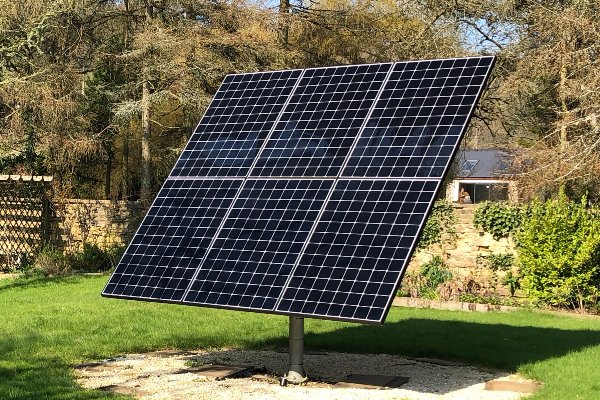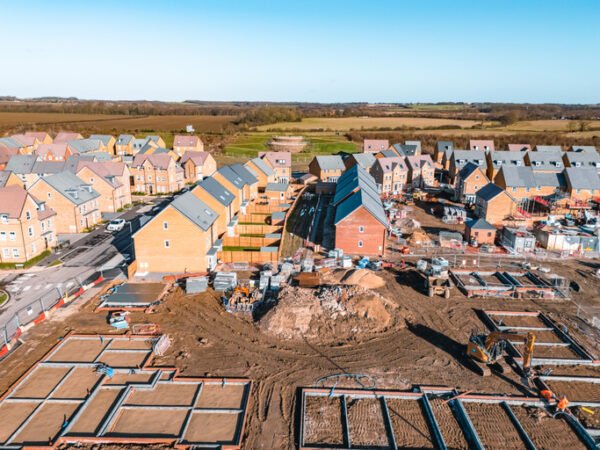This article first appeared in our COP27 special issue of My Green Pod Magazine, published on 10 November 2022. Click here to subscribe to our digital edition and get each issue delivered straight to your inbox
I discovered Heliomotion solar tracking technology by complete fluke in early 2018, when I was skimming through a Scandinavian in-flight magazine.
At the time I was looking for a solar solution for my own home; my roof features gables and Velux windows and has no south-facing pitch, meaning static solar PV wasn’t an option.
In contrast, Heliomotion solar panels are fixed to a column in the ground, and move to track the sun.
As well as providing a great solution to architectural challenges, the panels deliver 30-60% more energy than roof-based panels of similar dimensions.
I had never come across Heliomotion before; the system immediately seemed like a genius idea and I wanted to buy it, but quickly discovered the technology wasn’t available in the UK.
I contacted the company headquarters in Finland and the rest is history; I joined the team and started my solar tracking career managing Heliomotion’s marketing and global business development.
Make or break
The system won Build It magazine’s Best Home Technology award at the end of 2018, but this great start was quickly overshadowed by Brexit, a two-year Covid pandemic and the termination of the government’s solar subsidy – all of which slammed the brakes on our growth potential in the domestic solar market.
I soldiered on and won the 2020 P.E.A. Award for Energy in recognition for the work I had done to bring the technology to the UK and several other countries. Things were on the up – and early 2022 heralded a new beginning. Mask-wearing rules were dropped and the market began to pick up as normal sales activity resumed.
However in May 2022, our manufacturer in Sweden ceased production at very short notice – while I had orders placed. I had to make a huge decision: should I quit or go for it?
A few short weeks of thought, planning and discussions with friends and family later, I founded a brand-new production company, Bee Solar Technology Ltd, to manufacture Heliomotion solar tracking systems and sell them globally with associated products.
This happened at a time of global supply and logistics disruption, but we remained optimistic and found a local and very responsive family-run steel company, which managed to turn the prototype round very quickly.
We negotiated with several aluminium companies and found two that were able to supply us at a time of aluminium shortage.
We found a local fastening supplier who swung into action to help us source multiple nuts, bolts and washers, and our developer in Finland pulled out all the stops to supply control boards and sensors to meet our deadlines.
After sourcing 3D printing, stepping motors, transformers and various other components, I am proud to say that we delivered our first British-assembled systems in just under three months – a fantastic team achievement from a standing start.
How solar tracking works
The design and technology behind solar tracking is both highly complex and beautifully simple.
The systems are heliotropic, just like sunflowers; they turn and tilt slowly from sunrise to sunset so the panels are always facing the sun at the optimal angle.
This means that they generate a great deal more electricity than static systems; in the UK it’s around 40-45% more. As a result, six panels on a tracker have the same approximate generating capacity as 10 solar panels on a roof.
Our systems are dual axis, which means as well as turning 180 degrees horizontally over the course of the day, the vertical angle of the panels alters up and down according to the position of the sun.
They are controlled by GPS and a position sensor, so whatever the light level, they know which way they should be facing to optimise potential power generation. When the sun dips 6º below the horizon, they start to swing back, ready for sunrise the next day.
Unlike rooftop installations, which have rails and panels that require a team of people and scaffolding, our DIY systems have been designed specifically to be installed by a single person with a willing assistant.
No lifting equipment is required as the pieces weigh no more than 30kgs, and most are considerably lighter. They can be mounted quickly using ground anchors, which we supply with a custom base plate, using a power hammer available from hire shops.
The alternative option is a cubic metre concrete plinth, though this is a far less eco solution that requires a lot of digging and a concrete mixer.
 Play Video about This Rock Might Just Save The World
Play Video about This Rock Might Just Save The World Play Video about Play 2 hours of rock
Play Video about Play 2 hours of rock Play Video about Play 2 hours of brook
Play Video about Play 2 hours of brook Play Video about Play 2 hours of sheep
Play Video about Play 2 hours of sheep











































